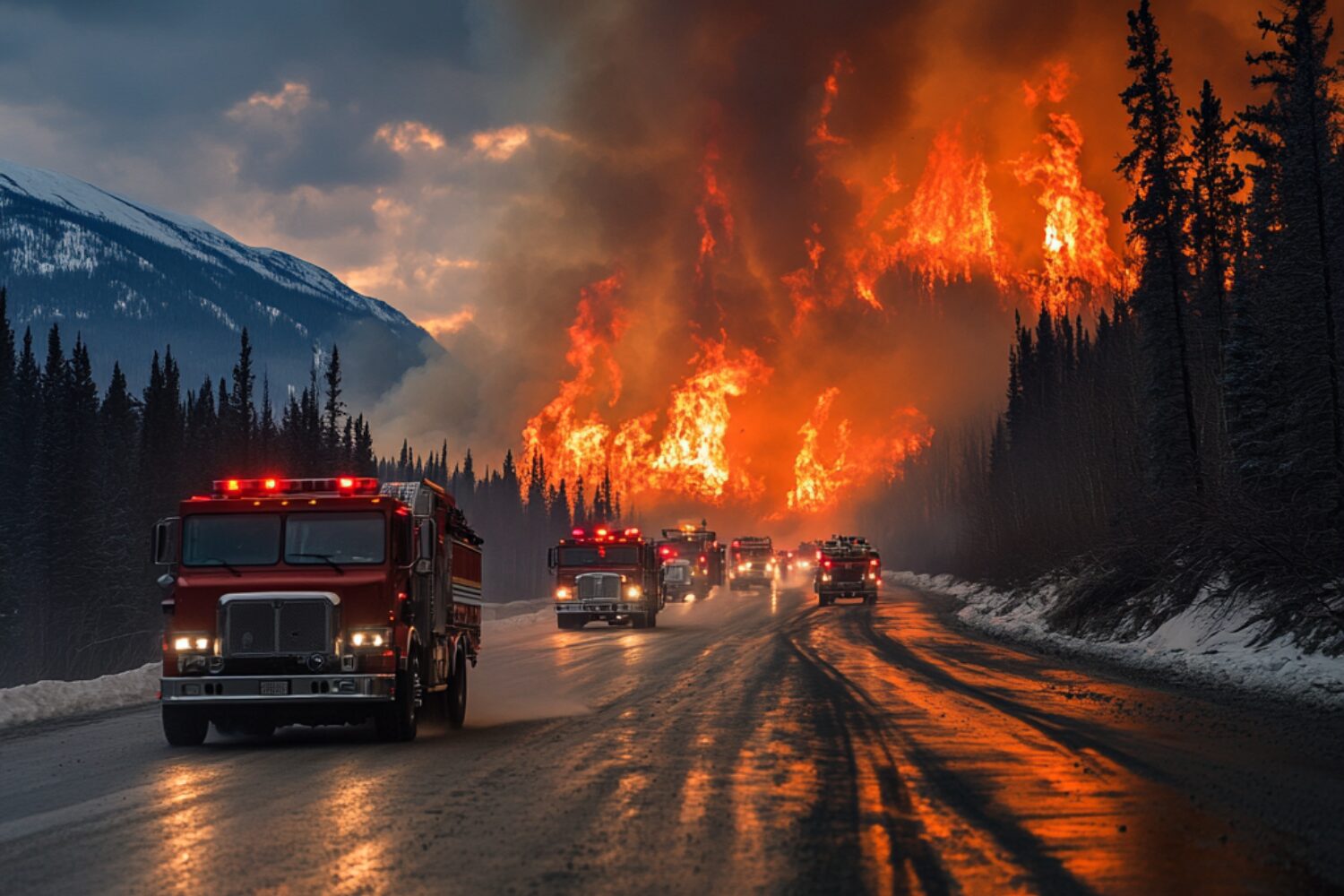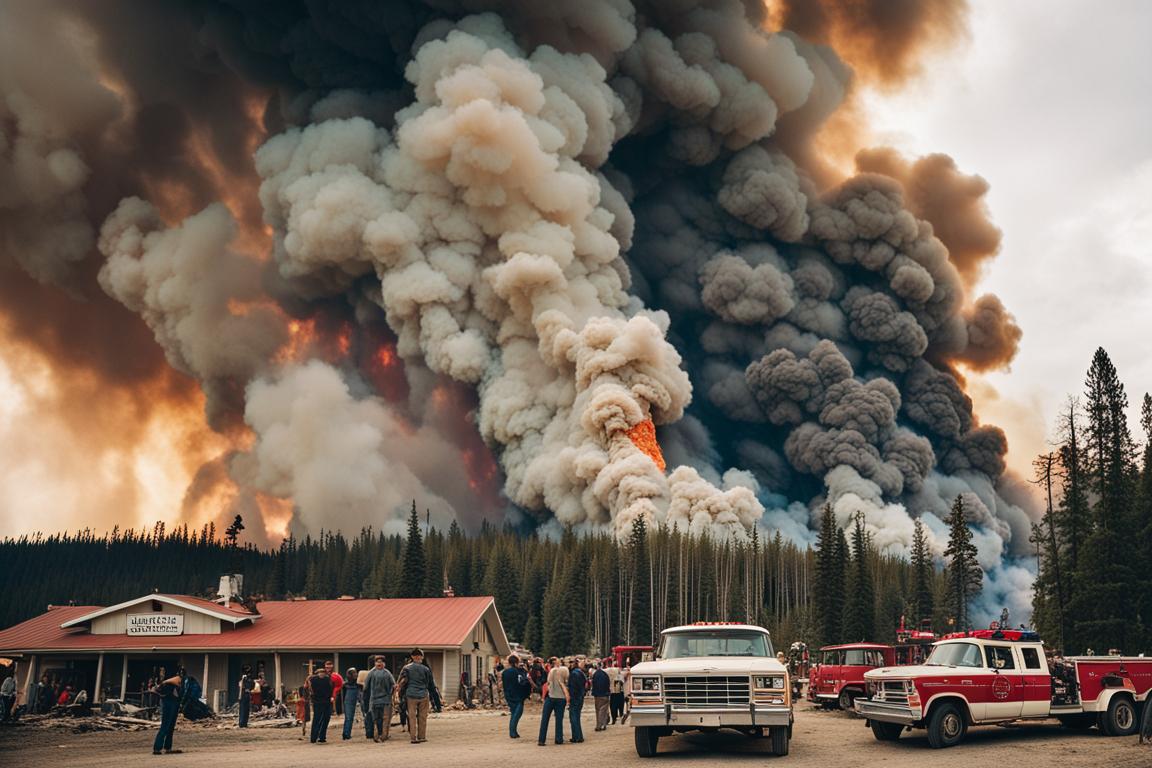
How To Prepare Your Home For A Wildfire In Canada
By: 911 Water Damage Experts
Wildfires are a growing threat in many parts of Canada, especially in the hotter months. With climate change driving more extreme weather conditions, these fires are becoming more frequent and intense.
In 2021, wildfires in Canada burned over 3.2 million hectares of land, affecting communities and ecosystems alike. As these fires become more unpredictable, preparing your home is crucial to reducing the risk of damage and ensuring your safety.
This guide will walk you through key steps to protect your home from wildfires, providing useful information and strategies to minimize your risks.
Understanding Wildfire Risks In Canada
Canada is no stranger to the devastating effects of wildfires. Regions like British Columbia, Alberta, Ontario, and parts of the North are particularly vulnerable due to dry conditions, high winds, and dense forests.
According to the Canadian Interagency Forest Fire Centre (CIFFC), wildfires in Canada have been increasing in frequency over the past decade, with the average number of hectares burned annually rising steadily. Wildfires spread rapidly, often starting in remote areas and then fanned by strong winds. Firefighters must act quickly, but the safety of your home largely depends on how well you’ve prepared it in advance.
Defensible Space: Creating A Buffer Around Your Home
A defensible space is an area around your home that is designed to prevent the spread of fire and protect your property from embers. Creating a defensible space is one of the most effective ways to increase the chances of your home surviving a wildfire. The basic idea is to remove or reduce the flammable materials around your house to slow the fire’s progress.
Start by clearing dead plants, leaves, and dry vegetation within 10 to 30 metres of your home. Trim trees and bushes to prevent the spread of fire through the canopy, and keep branches at least 3 metres away from your home. Creating firebreaks—gaps in vegetation, like gravel paths or non-combustible materials—also helps slow the spread of flames. The more defensible space you have, the better your chances of protecting your property.
Hardening Your Home: Fire-Resistant Materials
When preparing your home for a wildfire, it’s essential to consider using fire-resistant materials for construction and repairs. This includes your roof, siding, and windows, which are the most vulnerable parts of your home.
For roofing, opt for fire-resistant materials like metal, clay, or tile. Asphalt shingles may be cheaper, but they can be easily ignited by flying embers. For your siding, materials such as brick, stucco, or fire-resistant composite materials are great options. Installing ember-resistant vents can prevent embers from entering your attic and igniting the interior of your home. Make sure eaves and soffits are sealed tightly to prevent embers from settling in hard-to-reach areas.
Fire-Resistant Landscaping
Your landscaping plays a significant role in preventing the spread of wildfires. Choose fire-resistant plants and shrubs that are less likely to catch fire. Plants like succulents, ground covers, and other moisture-rich plants are a good choice. Avoid highly flammable species such as junipers, pines, and cypress, as these can quickly spread fire.
Maintain a healthy, well-watered lawn to help prevent it from drying out. It’s also crucial to avoid using flammable mulch like wood chips or bark; instead, use gravel or other non-combustible materials in your garden beds.
Fire Safety Equipment And Home Systems
Having the right equipment in place can be lifesaving during a wildfire. Ensure you have fire extinguishers readily available in key areas, such as the kitchen and garage. Smoke alarms should be installed throughout your home, and it’s essential to maintain them with regular battery checks.
Consider installing a sprinkler system, which can help protect your home from the threat of embers. If possible, set up a rainwater collection system or use a pool as an emergency water source. Having a consistent water supply can be crucial in case the fire department is unable to reach your area in time.
Preparing Your Property’s Access Points
In the event of a wildfire, emergency responders need quick access to your property. Make sure your driveway and any access roads are wide enough to accommodate emergency vehicles. Remove overgrown vegetation and clear the area around gates and fences to ensure they are easily accessible. Install a reflective address sign that is clearly visible from the road, as it helps emergency personnel locate your home quickly.
Emergency Kit Preparation For Wildfire Evacuation
In case you need to evacuate quickly, having a well-stocked emergency kit is essential. Your kit should include enough food, water, and medications to last for at least 72 hours. In addition to basic supplies, include essential documents, first aid items, flashlights, batteries, and personal identification. If you have pets, make sure to pack their food, water, and any necessary medications as well.
Don’t forget to prepare your vehicle with an emergency kit and keep your tank full in case of an urgent evacuation.
Developing A Family Evacuation Plan
One of the most important steps you can take to ensure your family’s safety is to develop a comprehensive evacuation plan. Your plan should include multiple escape routes in case one is blocked by fire or smoke. Designate a meeting point outside the affected area where all family members can reunite. Practice evacuation drills regularly so everyone knows exactly what to do and where to go.
If you have pets or livestock, make arrangements for their transportation and ensure that you have the necessary supplies. Staying informed is critical—sign up for local wildfire alerts and monitor social media accounts for updates from fire departments.
Staying Informed: Monitoring Wildfire Alerts
In today’s connected world, staying informed about the latest wildfire alerts is easier than ever. Sign up for emergency notifications from your municipality or provincial government, which will send you real-time updates on fire conditions and evacuation orders. Several mobile apps are available to track wildfires, including the Canadian Wildfire Information System (CWIS) and local government alerts.
Follow local authorities and fire departments on social media to stay up to date with important information. Being informed will allow you to act quickly if a wildfire threatens your area.
Preparing To Stay Or Evacuate
Deciding whether to stay or evacuate during a wildfire depends on several factors, including the fire’s proximity, the availability of evacuation routes, and local warnings. If you choose to stay, take precautions like closing windows and vents, and sealing any gaps where embers could enter.
Before leaving, move flammable materials away from your home, turn off gas and propane tanks, and close all windows and doors. If you evacuate, ensure that your emergency kit is ready to go, and follow local authorities’ instructions.
After The Wildfire: Post-Event Recovery And Safety
Once the danger of the wildfire has passed, it’s essential to assess the safety of your home before re-entering. Watch for downed power lines, smouldering debris, or structural hazards. If it’s safe, begin cleaning your property of ash and soot, as these can pose health risks. Ventilate your home by opening windows and using fans to clear smoke.
Contact your insurance company to report any damage and document your losses. If you’ve been exposed to wildfire smoke, consult a healthcare professional about potential respiratory issues.
FAQs
What Is Defensible Space, And Why Is It Important? Defensible space is an area around your home that is cleared of flammable materials, creating a buffer between your property and the wildfire. It’s important because it reduces the chance of the fire reaching your home and increases the effectiveness of firefighting efforts.
How Can I Make My Roof More Fire-Resistant? Consider using fire-resistant materials like metal, clay, or tiles for roofing. These materials are less likely to catch fire compared to traditional asphalt shingles, which can ignite from flying embers.
Should I Prune Trees Near My Home? Yes, pruning trees and shrubs is crucial to prevent the fire from spreading from the vegetation to your home. Keep branches at least 3 metres away from your house and avoid overhanging branches that could catch fire.
What Are Fire-Resistant Plants? Fire-resistant plants are those that are less likely to ignite or spread fire. Examples include succulents, groundcovers, and other moisture-rich plants. Avoid using highly flammable plants like junipers and cypress.
How Can I Protect My Home’s Windows from Wildfires? Install ember-resistant window screens and consider using fire-resistant glass for windows. Closing windows during a wildfire can help prevent smoke and embers from entering your home.
What Should I Include in My Emergency Kit for a Wildfire? Your kit should include food, water, medications, first aid supplies, flashlights, batteries, important documents, and items for pets. It’s essential to be prepared for at least 72 hours.
How Can I Ensure Emergency Vehicles Can Access My Property? Maintain a wide, clear driveway and clear overgrown vegetation around gates and fences. Install a reflective address sign that is visible from the road to help emergency responders locate your home quickly.
Should I Stay or Evacuate During a Wildfire? Follow local authorities’ instructions when deciding whether to stay or evacuate. If the fire is close, it’s generally safer to evacuate early rather than risk getting trapped.
What Are the Benefits of Fire-Resistant Landscaping? Fire-resistant landscaping can help slow the spread of a wildfire around your property by using non-combustible materials and fire-resistant plants. This reduces the risk of the fire reaching your home.
How Do I Stay Informed About Wildfires? Sign up for local government alerts, download wildfire-tracking apps, and follow fire departments on social media. Staying informed ensures you can take action quickly when a wildfire threatens your area.
Conclusion
Preparing your home for a wildfire in Canada is a critical step in protecting both your property and your loved ones. By taking proactive measures, such as creating defensible space, using fire-resistant materials, and staying informed, you can significantly reduce the risk of damage and enhance your safety during wildfire season. With the right preparation, you can be ready to face a wildfire with confidence.
If you have any questions about our article “How To Prepare Your Home For A Wildfire In Canada” or need water damage restoration services contact us at 1-833-WE-DRY-IT or connect with us on social media.
Related Posts
Mould Removal Restoration Articles
5 Signs You Have Mould Growing In Your Walls
“Can I Remove Mould Myself?” Our Mould Removal Experts Have Answers
7 Must-Know Reasons Why You Should Get A Mould Inspection Before Buying A House
Does Mould Attract Bugs? Yes And Here’s What Kind And Why
How To Remove Mould From The Attic [Mould Prevention Tips Inside]
How Rain Causes Mould Growth-Prevention Tips Included
Must-Know Tips: How To Remove Mould In Your Basement
Water Damage Restoration Articles
What you can expect from a fire damage restoration company
Water damage prevention tips from the most common problems we’ve seen
Top causes of water damage in commercial buildings and how to find them
Must-know water damage tips: What to do after your house floods
What does good water damage restoration look like?
DIY water damage restoration and the hidden dangers
How to choose the right water damage company
Flast floods: What to do before, during and after a flash flood
What to do when your attic leaks?
Fire Damage Restoration Articles
How to clean up after a house fire
Fire damage restoration checklist
Fire damage tips: 6 hazards property owners miss
How smoke from fires can negatively affect your health
What are the most common causes of house fires?
10 helpful smoke damage cleaning tips
Related Water Damage Services
Fire damage restoration services
Water damage restoration services
Emergency cleanup services
Mould removal services
Weather damage services


